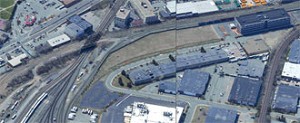
|
| If the state gets its way, this is what you'll have at Inner Belt. |
|
Activists and officials angered as state sticks to plan
By Jack Nicas
The
state transit office is sticking to a plan that would add a 12-acre
maintenance facility to prime developable land in the
long-underutilized Inner Belt business district.
And local activists and officials are not happy.
"Unless
there is a great deal of equity interjected into the…disproportionate
use of Somerville for maintenance and storage and other uses that don't
produce revenue for the city…how can you expect anyone to support
this plan?" asked State Rep. Denise Provost at a meeting on the issue
Wednesday. As she concluded, the audience of Somerville and Medford
residents erupted into applause.
In a recently released report
from the state, Yard 8 in the Inner Belt was recommended as the best
location for the maintenance and storage facility that would service
Green Line trains. The Inner Belt already hosts a maintenance facility
for commuter rail trains. Another facility there would block the area
off and end any hopes the city may have of commercial development that
could ease the burden on homeowners in the city, according to Chamber
of Commerce President Stephen Mackey.
At Wednesday's Green
Line Advisory Group meeting, some members voiced their disapproval of
the state's findings and were met with the public's thunderous applause.
"It
is not acceptable to hamstring development of the Inner Belt in order
to satisfy the MBTA's wish list," said city-appointed board member Jim
McGinnis.
Mackey tried to illustrate the transit office's bias
towards the Cambridge development NorthPoint. He quoted the state's
report: "By changing the original scope of the NorthPoint project,
there would be significant financial impacts to both the project
developer and the three municipalities."
"The only time you
let yourself be governed by a development plan is when NorthPoint is
involved," he said to state officials at the meeting. "All the other
schemes just involve Somerville. But the private interests, the public
interests, and the fiscal impact on the municipality are never raised."
The
entire facility would take up approximately 10 to 12 acres: an
estimated 5.5 acres for an 80-car storage yard, five acres for a 50,000
square foot maintenance facility, and one acre for employee parking.
Transit
office engineers examined 11 sites for the facility, seven of which
were located in Somerville, according to the report. Three of the 11
sites were deemed feasible and ten "schemes," or plans, were created
for those three sites.
Of the ten, engineers whittled the options down to three possible plans:
"Scheme
D2" would separate the storage yard and the support facility,
positioning the latter in "the least developable plot of land,"
according to project engineer John F. Burckardt. The plan would require
5.7 acres of privately owned land, including the entire 22 Water St.
planned-development site. It was determined as the most operationally
viable.
The city-proposed plan, "Scheme J," would not use Yard
8 and be "potentially compatible with Inner Belt development,"
according to the report. It would require 12.2 acres of privately owned
land, encompassing existing businesses within the J-shaped curve of
Inner Belt Road. The acquisition of this land would cost over $60
million and present a "very high risk" to delay the extension of the
Green Line through Somerville, according to the report.
The
report concluded that the state's initial recommendation, "Site 10,"
which is Yard 8 and an adjacent vacant lot referred to as "the grassy
knoll," is the best possible plan. It would require 6.2 acres of
privately owned land: the remaining two acres the MBTA does not own of
Yard 8 and all 4.2 acres of "the grassy knoll." The report lists it as
the least expensive plan and a low risk to delay the extension.
If
"Site 10" were chosen as the maintenance facility location, maybe the
most impacted Somerville residents would be those in the Brick Bottom
neighborhood. Several spoke at Wednesday's meeting.
"What struck
me about this whole discussion was the totally impersonal quality of
the analysis, the nonhuman analysis. There are 200 people living
there," said 77-year-old Brickbottom resident and artist George Gabin.
"For 20 years we created a community. Now, this tiny little place is
the center of all the development that you've planned. What will
happen? What will happen to our health? Maybe you're trying to get rid
of us."
The state transit office could not be reached for comment.
The
final decision rests with state officials, meaning Gov. Deval Patrick
will have the final say on the facility's location. The next step in
the process is the finalization of the yet-to-be-released Draft
Environmental Impact Report, a document originally scheduled for
September.
Some Advisory Group members requested the presence
of the Executive Office of Housing and Economic Development at the next
meeting. "If the state economic development board was part of this
process, I don't think we'd be at this problem at this late of a date,"
Mackey said.
The next Green Line Advisory Group meeting is
Wednesday, Dec. 1 at St. Clements High School (4 to 6 p.m., 579 Boston
Ave., Medford). Some members said they look to achieve more compromise
then.
"We're not saying get out of our backyard," Mackey said, "but at least work with us in the part of our backyard you use." |
Reader Comments